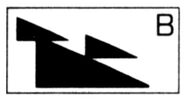| | |
Template:Organization infobox
- "As officers of the Imperial Navy, your loyalty is expected… and demanded. Resignations are not permitted at this time. The Galaxy remains unstable. You will do your duty or you will share the late Captain Dallin's fate."
- ―Darth Vader, after the death of Captain Jace Dallin
The Imperial Navy, also known as the Imperial Starfleet, Imperial Fleet, Imperial Battlefleet, or Imperial Space Service, was the military arm of the Galactic Empire charged with maintaining security in Imperial space. It was formed from the Republic Navy, and as such was still under Naval Command.
At its peak, it fielded millions of warships and fulfilled Emperor Palpatine's will throughout the galaxy.
History

Imperial-class Star Destroyers escorting Executor.
The Imperial Navy conducted itself by the Imperial Naval Code, a set of martial laws and regulations created to guide the massive military organization. Under the Non-huMan rule, the vast majority of personnel in the Imperial Starfleet were male Humans, although some Human females, such as Admiral Daala, and even other species were also in the service, such as the Chiss Grand Admiral Thrawn.
Specific responsibilities of the Imperial Navy included defending Imperial citizens from space-based threats such as pirates, smugglers, and other armed governments, enforcing Imperial will, and overseeing commerce through customs and blockade operations. The Imperial Navy also performed orbital bombardments, transported major ground force deployments, and supported them with space and aerial support.
Not too long after the defeat at the Battle of Endor, the Galactic Empire split up into warring factions led by warlords, and the Imperial Navy splintered along with it. While much of the remnants of the Imperial Navy were later reunited under impressive Imperial commanders, the military organization ceased to be reunited as a whole after the death of Emperor Palpatine. By the end of the Galactic Civil War, a navy that numbered in the millions was reduced to mere thousands with just two-hundred Star Destroyers remaining. It would take more than a century before the Imperial Navy restored itself to its former glory.
Key ships of the fleet

A COMPNOR member on a public relations trip observes a naval maneuver.
The most recognizable symbol of the Imperial Starfleet was the Imperial-class Star Destroyer, which peaked at twenty-five thousand vessels, although millions of starships of different designs and functions were fielded for various purposes.
Most major capital ships, battlestations and logistics vessels were constructed by Kuat Drive Yards, Loronar Corporation, and Rendili StarDrive during the height of the Galactic Empire. The shipyards at Corellia supplied the Empire with gunships, corvettes and larger warships. Additionally, countless shipyards supplied the Imperial Starfleet with support ships such as Carrack-class light cruisers, Lancer-class frigates, Strike-class cruisers, and escort carriers. In 0 BBY, it was estimated that the combined firepower of the entire fleet could do as much damage as two Death Stars.
Education
- "Our credo is 'Service. Fealty. Fidelity.' This may be the first time you have heard it. By the time you graduate, it is one you will never forget."
- ―Fleet Admiral Holt during Imperial Naval Academy cadet indoctrination speech
Naval recruits first attended the Imperial Academy to gain the basis of their higher education and military discipline, and then continued their education at the Imperial Naval College, where Academy graduates received specific training on naval operations, combat, and command functions. Finally, non-commissioned officers and recent graduates of the Imperial Naval College could participate in a training program through the Imperial Navy Officers' School to focus on military customs and courtesies, military history, leadership, officership, deck command exercises, discipline drills, and other pertinent areas of education of potential officers. Upon graduation, trainees were commissioned in the Imperial Navy as lieutenants.
Organization

A parade on Anaxes.
The Imperial Navy used an overall strategy of focusing on capital ship firepower rather than starfighter superiority. This was reflected through the design of their starships, the formation of their naval units and the overall organization of the force.
Command
An individual command, a single starship, was the building block of the Imperial Starfleet. Achieving command of a starship, no matter its size, was point of pride in an officer's career. Officers commonly turned down impressive staff promotions in the hopes of receiving a ship command, although serving as a staff officer on a prominent starship, such as a squadron flagship, was often considered a fast track for promotion.
Line of battle
The most basic unit in the Imperial Navy was a line of battle, or simply a line. The Imperial Starfleet shaped four to twenty starships into lines, depending on the type of line. Commanded by a captain of the line, the line was the most amorphous level of organization in the Starfleet. The Imperial Starfleet Order of Battle outlined seven types of lines: attack, heavy attack, reconnaissance, pursuit, skirmish, troop and bombard. Attack and heavy attack lines aggressively engaged enemy starships in combat, reconnaissance lines gathered intelligence of the disposition of enemy forces, pursuit lines chased and trapped retreating enemies, and skirmish lines harassed capital starships and engaged enemy picket lines. A troop line consisted of two Evakmar-Kuat Drive Yards Corps Transport vessels, two escort vessels, and frequently two Strike-class cruisers. Its function was the deployment of Army units. A bombard (or torpedo) line typically consisted of two Torpedo Spheres.
In addition to the seven types of lines, the Imperial Navy considered an Imperial-class Star Destroyer a line in itself. While an Imperial-class Star Destroyer may have been able to act as an attack line and its complement of starfighters as a skirmish line, the decision to give commanders the option to field a heavy cruiser as a line unto itself was more political than tactical. After a naval staff study suggested a Star Destroyer was the field equivalent of the smallest of naval squadrons, the Admiralty decided that, as there were more lines than squadrons, designating the Star Destroyer as a line unit would get them more Star Destroyers. The Admiralty's thinking prevailed.
Squadron

Imperial-class Star Destroyers and TIE Fighters shortly before the Battle of Endor, 4 ABY.
A squadron was the smallest independent operating unit in the Imperial Navy. Composed by several lines, a squadron was commanded by an admiral and ranged from 14 to 60 ships, depending upon the composition of the lines in the squadron. A squadron was the largest concentration of ships normally assigned to a single system. The Galactic Republic designated units of identical configuration as fleets. Those units were the total naval presence in a sector. Thus, the squadron was a useful measure of the growth of the Imperial military after the establishment of Emperor Palpatine's New Order.
Similar to lines, the Imperial Navy's Order of Battle designated four types of squadrons: light, heavy, battle, and bombard. Light squadrons patrolled areas known to be safe with two attack lines, a skirmish line and a reconnaissance line. Heavy squadrons engaged planetary systems that possessed known enemy presences, with either two heavy attack lines, an attack line and a reconnaissance line for situations where the enemy's position and composition was unknown, or with three heavy attack lines and a skirmish line for situations where the enemy was known to be defending a fixed asset. It was common to assign Victory-class Star Destroyers to the latter type of heavy squadron. Battle squadrons contained an Imperial-class Star Destroyer. In addition to the Star Destroyer, there were at least three lines, two attack lines and one pursuit line, for an average of 18 ships. The mere arrival of a battle squadron, and more importantly, an Imperial-class Star Destroyer, was often enough to put down a planetary revolt or scare off an armed space-threat. Bombard squadrons subjugated worlds in open rebellion that had developed planetary defenses including multilayered planetary shields and large planetary guns with four torpedo spheres, a skirmish line, and a pursuit line.
Systems force
A typical Imperial hangar.
A systems force combined several squadrons under the command of an admiral, referred to as a commodore while leading a systems force. These combined forces were responsible for Imperial Starfleet actions across multiple star systems. Rather than outline specific formations of system forces, the Imperial Starfleet Order of Battle lent flexibility to commodores to pool the whole of their naval resources and shape them as necessary missions required.
Force superiority pooled at least three battle squadrons and a light squadron. With a minimum of three Imperial-class Star Destroyers and nearly 90 other starships, force superiority's mission was to achieve space superiority, defined as, "the complete absence of hostile craft within the orbital space of controlled worlds, and no chronic enemy ship activity within the entire system."
Force escort protected crucial commercial shipments, economically essential space installations or facilities, and hunted down harassing pirates. With at least two heavy squadrons and two light squadrons, force escort was the most flexible of the force pools. Commodores used force escort to run a variety of missions, knowing well that their large starship count and organizational flexibility would allow for their completion. Where force superiority was given the maxim "always send enough", force escort bore the maxim "never send too much".
System forces engaged threats that force superiority could not successfully destroy. By swapping out the light squadron for a fourth battle squadron, a commodore could get enough force to ensure complete domination of a target area.
Fleet
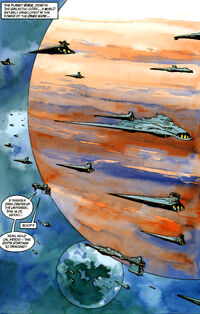
Where all previous units were generally bound to specific system or set of systems, the Imperial Navy designated a fleet as a "sector resource", allowing it to operate on a sector-wide scale. A fleet was the smallest unit transferred between sectors. With such a large number of units, there were thousands of potential types of fleet alignments. Common fleet deployment types included superiority fleets, assault fleets, and bombard fleets. Other examples of alignments that a fleet might have taken included a deepdock fleet, support fleet, or ordinance fleet.
Superiority fleets maintained space superiority in sectors with "four or fewer world confirmed hostile to the New Order, and no more than 16 additional worlds with confirmed significant hostile elements", a superiority fleet was deployed. With six Imperial-class Star Destroyers and almost 400 other starships, a superiority fleet was presumed to be a sufficient force for relatively calm sectors.
Assault fleets transported huge numbers of Imperial Army and Navy troops to coordinate ground operations, while maintaining space superiority around the targeted systems. With two transport forces and two force escorts, an assault fleet engaged in massive planetary and system-wide ground campaigns.
Bombard fleets contained an average of 416 ships, allocated between two system bombards and two force escorts. Bombard fleets were assigned to sectors where the Empire had determined the probability of repressing the Rebellion in the sector to be less than even. System bombards were used when the Empire would rather completely destroy a world than see it fall into Rebel hands.
Sector group
A sector group was the sum total of Naval strength which the Empire expected to commit to a normal sector. A high admiral commanded a sector group, a title usually granted to the Moff who governed the sector. In sectors that were involved in constant and severe naval actions, the High Admiral was a separate position from the Moff. A sector group could be expected to contain at least 2,400 ships, 24 of which were Star Destroyers (Imperial-class Star Destroyers were the norm, but some groups contained older model Star Destroyers), and another 1,600 combat starships.
Regional, oversector and strategic command
Regional, oversectorial and strategic military commands existed as well, but the details of their compositions were mostly unknown.
Black Sword Command was a regional command that defended the Core regions from threats eminating from the galactic rim. It had three Super Star Destroyers as part of its fleet assets. Azure Hammer Command, based out of Anaxes, defended Sector Zero and consisted of 57 capital ships, led by the Super Star Destroyer Whelm. Additionally, a full ten percent of the entire Imperial Navy was kept in reserve in the Core Worlds, so as to be able to quickly respond to threats throughout the Galaxy. In the Outer Rim Territories, a fleet with 19 Imperial-class Star Destroyers and three Immobilizer 418 cruisers, the latter supplied by Imperial Drydock IV was also kept.
Roving fleets aimed at specific tasks were fielded at several points in Imperial history. Notable units included Death Squadron and Scourge Squadron, which hunted for Rebel bases in the Outer Rim. There was also the Vengeance Battle Group, used by the Dark Jedi Jerec to search for the Valley of the Jedi, and the armada assembled by Admiral Mils Giel, for the purpose of transporting a vital biological device from the Outer Rim to Imperial Center.
Infantry units
- Imperial Marines
- Imperial Navy crewman
- Imperial Navy troopers
- Imperial pilots
Gallery of personnel types
Capital ship classes
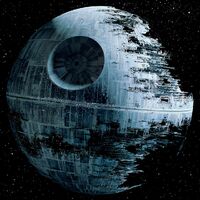
The Death Star II, one of the deadliest weapons developed by the Empire.
Battlestations and superweapons
- Death Star I
- Death Star II
- Dedicated Siege Platform
- Derilyn Space Defense Platform
- Galaxy Gun
- Golan Space Defense SpaceGun
- Golan II Space Defense SpaceGun
- Golan III Space Defense NovaGun
- Sun Crusher
- Tarkin
- World Devastator
Battleships
- Admiral Giel's flagship
- Advanced Star Destroyer (post-Remnant Empire only)
- Eye of Palpatine
- Eclipse-class Star Dreadnought
- Executor-class Star Dreadnought

The Super Star Destroyer Vengeance with elements of the Vengeance Battle Group.
- Loronar battleship
- Mandator I-class Star Dreadnought
- Mandator II-class Star Dreadnought
- Rendili battleship
- Sovereign-class Star Dreadnought
- Star Dreadnought (pre-Yavin)
- Super Star Destroyer (Death Star)
- Super Star Destroyer (pre-Yavin)
- Super Star Destroyer prototype
Battlecruisers
- Praetor-class Star Battlecruiser
- Procurator-class Star Battlecruiser
- Star Destroyer-class battlecruiser
- Super Star Destroyer Vengeance
Cruisers
- Allegiance-type Super Star Destroyer
A Super Star Destroyer, either a Star Cruiser or a Star Battlecruiser, orbiting Byss with Star Destroyer escort.
- Kuat heavy cruiser
- Republic-class cruiser (Imperial Remnant)
- Star Cruiser (Imperial)
- Super Star Destroyer (Byss)
Destroyers
- Demolisher-type Star Destroyer
- Harrow
- Imperial I-class Star Destroyer
- Imperial II-class Star Destroyer
- Interdictor Star Destroyer
- Kuat destroyer
- Main communications ship
- Pellaeon-class Star Destroyer (post-Remnant Empire only)
An Imperial I-class Star Destroyer, signature vessel of the Imperial Navy.
- Star Destroyer (Byss)
- Star Destroyer (multi-mile)
- Star Destroyer (pre-Hoth)
- Tector-class Star Destroyer
- Turbulent-class Star Destroyer (Imperial Remnant)
- Venator-class Star Destroyer
- Victory I-class Star Destroyer
- Victory II-class Star Destroyer
Carriers and assault ships
- Acclamator I-class assault ship
- Assault ship
- Combat escort carrier
- Demolisher-type Star Destroyer
- Escort Carrier
An Imperial carrier in Giel's armada.
- Imperial carrier
- Starfighter carrier
- Spiral-class assault ship
- Venator-class Star Destroyer
- Doomgiver
Frigates
- Acclamator II-class assault ship
- Bayonet-class light cruiser
- Carrack-class light cruiser
- Class II frigate
- Class 1000 cruiser
- Combat escort carrier
- Detainer CC-2200 interdictor cruiser
- Dragon-class heavy cruiser
- Dreadnaught-class heavy cruiser
A Dreadnaught-class heavy cruiser, representative of a durable class that spanned centuries and governments.
- Immobilizer 418 cruiser
- Imperial fast frigate (post-Remnant Empire only)
- Lancer-class frigate
- Nebulon-B escort frigate
- Nebulon-B2 frigate
- Neutron Star-class bulk cruiser
- Star Galleon-class frigate
- Strike-class cruiser
- Victory II-class frigate
- Vindicator-class heavy cruiser
- Zebulon-B frigate
Corvettes and gunships
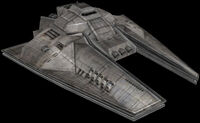
A Broadside-class cruiser kdb-1, an Imperial missile corvette.
- Assassin-class corvette
- Broadside-class cruiser kdb-1
- Corellian gunship
- CR90 corvette
- Crusader-class corvette (Imperial Remnant)
- Lianna-class corvette
- Light Corvette
- Pursuit-class light cruiser
- Tartan-class patrol cruiser
- Ye-4 gunship
Starfighters
Multi-purpose
- ARC-170 starfighter
- Alpha-class Xg-1 Star Wing
- Alpha-3 Nimbus-class V-wing starfighter
- Belbullab-22 starfighter
- Delta-7 Aethersprite-class light interceptor
- Emperor's Royal Guard TIE/In starfighter
- Eta-2 Actis-class light interceptor
- I-7 Howlrunner
- INT-4 Interceptor
- Predator-class fighter (post-Remnant Empire only)
- Preybird-class starfighter
- Skipray Blastboat
- Super TIE/ln starfighter
- TIE Advanced x1
- TIE Aggressor
- TIE Avenger
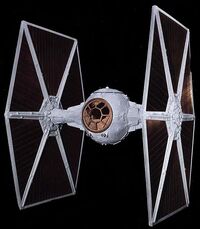
A TIE/ln starfighter.
Scout vessels
- Imperial sentry ship
- IPV/4 patrol ship
- IR-3F Patrol Craft
- ISP-6 Imperial Shuttle Pod
- Lightstealth-18 Reconnaissance Ship
- MRX-BR Pacifier
- Out System Scout Vessel
- PB-950 patrol boat
- Predator I Probe-Mate jump pod
- TIE/fc starfighter
- TIE/rc starfighter
- TIE Scout
- TIE Vanguard
Stealth
Droid
Bombers
Experimental
Support ships
Logistics vessels
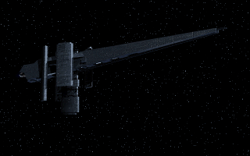
Arc Hammer factory ship.
- Action VI transport
- Arc Hammer
- C-3 passenger liner
- Carillion-class starship
- Combat Utility Vehicle
- Communications ship
- CT-11 space tug
- Empire prison ship
- Field Secured Container Vessel
- Harbinger courier ship
- Heavy Lifter
- Imperial dungeon ship
- Imperial Leviathan
- Imperial state ship
- Imperial transport
- Imperial cargo ship
- ISB Operations Ship
- Mobile repair base
- Modular Taskforce Cruiser
- Star Galleon-class frigate
- StarTrain
- Tech 4 Plexus Droid Vessel
- Trenchant-class cruiser
- Type II orbital repair yard
- U-33 orbital loadlifter
- Utility Tug
- Worldcraft
- World Devastator
Dropships and landing craft

- Dark Trooper hyperspace capsule
- Imperial dropship transport
- Kuat dropship
- Sentinel-class landing craft
- Imperial loader shuttle
- Theta-class AT-AT barge
- TIE lander
- Warlord Dropship
- Y-85 Titan dropship
Shuttles
- Curich-class shuttle
- CX-5011 PeopleMover
- Delta-class shuttle
- Delta-class DX-9 stormtrooper transport
- Delta-class JV-7 escort shuttle
- Gamma-class assault shuttle
- Grek-class troop shuttle
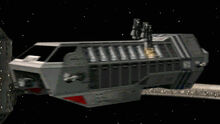
Spacetroopers disembarking from a Gamma-class assault shuttle.
- Kappa-class shuttle
- Lambda-class shuttle
- Low Altitude Assault Transport/infantry
- Mu-1-class shuttle
- Mu-2-class shuttle
- Nu-class Imperial Shuttle (post-Remnant Empire only)
- Theta-class shuttle
- TIE boarding craft
- TIE/sh shuttle
- Tribune-class shuttle
- Zeta-class shuttle
Behind the scenes
Starship classifications
It should be noted that considering the nomenclature of ship classification used by real life navies, some Star Wars starships appeared to be misnamed. However, it is to be expected that different cultures and societies go by internally rationalized classification-systems.
The Empire used different scales to classify their vessels. One of which culminated with Star Destroyers and Super Star Destroyers lumped into a sub-category of cruisers, and another which treated Star Destroyers as destroyers and further divided Super Star Destroyers into Star Cruisers, Star Battlecruisers and Star Dreadnoughts. The former system was more often referenced, as many of the threats against the Empire were on a level that required little more than one Star Destroyer or a flotilla of them.
Imperial identification procedures
It has not been established that starships of the Imperial Navy carry a nationality prefix, as most modern world navies do, though it should be noted that starships serving in the Grand Army of the Republic (GAR) during the Clone Wars carried the prefix "RSS," presumably indicating "Republic Star Ship." During the New Order, a vessel hailing another craft or station establishes communications by identifying itself with the term "Imperial", followed by the ship's class designation and finally the actual name.
For example, Garrett would therefore call itself "Imperial Star Destroyer Garrett", as you can hear it in a transmission when playing the computer game Star Wars: TIE Fighter. Also, as a lot of smaller ships in the vast armada of the Empire do not even bear a real names but only registration numbers, it would sound kind of ridiculous when a vessel would identify itself with a tag (like "this is ISS 019"). Instead, in the tutorial of the computer game Star Wars: Empire at War, you can see an Acclamator identifying itself as "Imperial Acclamator Oh-One-Niner". Some novels, like Republic Commando: Hard Contact, make it seem likely that this procedure has already been common in the navy of the Galactic Republic, except with the term "Republic" being used in place of "Imperial".
Note that this is but a hypothesis, as this topic has never been discussed by any official sources. Yet, a large number of novels and computer games are using the system described above, so there seems to be some kind of continuity, or at least an established habit of the different authors.
Appearances
Sources
- Attack of the Clones: Incredible Cross-Sections
- Revenge of the Sith: Incredible Cross-Sections
- Star Wars Sourcebook
- Cracken's Rebel Operatives
- Imperial Sourcebook
- Imperial Sourcebook, Second Edition
- Galaxy Guide 3: The Empire Strikes Back
- The Illustrated Star Wars Universe
- Inside the Worlds of Star Wars Trilogy
- The Essential Guide to Characters
- The Essential Guide to Vehicles and Vessels
- The New Essential Guide to Vehicles and Vessels
- Roleplaying Game Revised Core Rulebook
- Star Wars Legacy 0
- Star Wars Legacy 0½
- Starships of the Galaxy (2007)
See also
- Imperial military uniforms
- List of Imperial military personnel
- List of Imperial military units
- Rank Insignia of the Galactic Empire





















